An Approach to Understanding the Hydration of Cement-Based Composites Reinforced with Untreated Natural Fibers
Abstract
:1. Introduction
2. Materials and Methods
2.1. Materials
2.2. Test Methods
74 44 100 18
100 56 44
3. Results and Discussion
3.1. Differential Thermal and Thermogravimetric Analysis (TGA/dTGA)
3.2. X-ray Diffraction (XRD)
3.3. SEM–EDX
4. Conclusions
Author Contributions
Funding
Data Availability Statement
Conflicts of Interest
References
- Riofrio, A.; Cornejo, M.; Baykara, H. Environmental performance of bamboo fibers and sugarcane bagasse reinforced metakaolin-based geopolymers. Case Stud. Constr. Mater. 2022, 17, e01150. [Google Scholar] [CrossRef]
- Claramunt, J.; Ardanuy, M.; García-Hortal, J.A.; Filho, R.D.T. The hornification of vegetable fibers to improve the durability of cement mortar composites. Cem. Concr. Compos. 2011, 33, 586–595. [Google Scholar] [CrossRef]
- Gioffré, M.; Navarra, G.; Cavalagli, N.; Lo Iacono, F.; Gusella, V.; Pepi, C. Effect of hemp bio composite strengthening on masonry barrel vaults damage. Constr. Build. Mater. 2023, 367, 130100. [Google Scholar] [CrossRef]
- Verma, S.K.; Dwivedi, V.K.; Dwivedi, S.P. Utilization of Reinforced Palm Fibers Used for Composite Materials—A Review. In Advances in Mechanical and Energy Technology; Springer: Singapore, 2023; pp. 187–196. [Google Scholar]
- Martinelli, F.R.B.; Ribeiro, F.R.C.; Marvila, M.T.; Monteiro, S.N.; Filho, F.D.C.G.; Azevedo, A.R.G.D. A Review of the Use of Coconut Fiber in Cement Composites. Polymers 2023, 15, 1309. [Google Scholar] [CrossRef] [PubMed]
- Guizzardi, G.Z.; da Silva Machado, M.; Michelon, W.; Vicente Filipak Vanin, D. On the mechanical behaviour of natural sisal fibre reinforced cement paste. Proc. Inst. Civ. Eng. Constr. Mater. 2022. [Google Scholar] [CrossRef]
- Azevedo, A.R.G.; Lima, T.E.S.; Reis, R.H.M.; Oliveira, M.S.; Candido, V.S.; Monteiro, S.N. Guaruman fiber: A promising reinforcement for cement-based mortars. Case Stud. Constr. Mater. 2022, 16, e01029. [Google Scholar] [CrossRef]
- Mydin, M.A.O.; Nawi, M.N.M.; Odeh, R.A.; Salameh, A.A. Potential of Biomass Frond Fiber on Mechanical Properties of Green Foamed Concrete. Sustainability 2022, 14, 7185. [Google Scholar] [CrossRef]
- Morán, J.I.; Alvarez, V.A.; Cyras, V.P.; Vázquez, A. Extraction of cellulose and preparation of nanocellulose from sisal fibers. Cellulose 2008, 15, 149–159. [Google Scholar] [CrossRef]
- Poletto, M.; Júnior, H.L.O.; Zattera, A.J. Thermal Decomposition of Natural Fibers: Kinetics and Degradation Mechanisms. In Reactions and Mechanisms in Thermal Analysis of Advanced Materials; 2015; pp. 515–545. Available online: https://onlinelibrary.wiley.com/doi/10.1002/9781119117711.ch21 (accessed on 1 January 2022).
- Popescu, M.-C.; Popescu, C.-M.; Lisa, G.; Sakata, Y. Evaluation of morphological and chemical aspects of different wood species by spectroscopy and thermal methods. J. Mol. Struct. 2011, 988, 65–72. [Google Scholar] [CrossRef]
- Slopiecka, K.; Bartocci, P.; Fantozzi, F. Thermogravimetric analysis and kinetic study of poplar wood pyrolysis. Appl. Energy 2012, 97, 491–497. [Google Scholar] [CrossRef]
- Pickering, K.L.; Efendy, M.G.A.; Le, T.M. A review of recent developments in natural fibre composites and their mechanical performance. Spec. Issue Biocompos. 2016, 83, 98–112. [Google Scholar] [CrossRef] [Green Version]
- Rong, M.Z.; Zhang, M.Q.; Liu, Y.; Yang, G.C.; Zeng, H.M. The effect of fiber treatment on the mechanical properties of unidirectional sisal-reinforced epoxy composites. Compos. Sci. Technol. 2001, 61, 1437–1447. [Google Scholar] [CrossRef]
- Wei, J.; Ma, S.; Thomas, D.G. Correlation between hydration of cement and durability of natural fiber-reinforced cement composites. Corros. Sci. 2016, 106, 1–15. [Google Scholar] [CrossRef]
- Bilba, K.; Arsene, M.-A. Silane treatment of bagasse fiber for reinforcement of cementitious composites. Compos. Part Appl. Sci. Manuf. 2008, 39, 1488–1495. [Google Scholar] [CrossRef]
- Cooke, A.M. Durability of Autoclaved Cellulose Fiber Cement Composites; Building Materials and Technology Pty Ltd.: Sydney, NSW, Australia, 2007. [Google Scholar]
- Pehanich, J.L.; Blankenhorn, P.R.; Silsbee, M.R. Wood fiber surface treatment level effects on selected mechanical properties of wood fiber–cement composites. Cem. Concr. Res. 2004, 34, 59–65. [Google Scholar] [CrossRef]
- Toledo Filho, R.D.; de Andrade Silva, F.; Fairbairn, E.M.R.; de Almeida Melo Filho, J. Durability of compression molded sisal fiber reinforced mortar laminates. Constr. Build. Mater. 2009, 23, 2409–2420. [Google Scholar] [CrossRef]
- de Andrade Silva, F.; Melo Filho, J.A.; Toledo Filho, R.D.; Fairbairn, E.M.R.; Hegger, J.; Brameshuber, W.; Will, N. Mechanical Behavior and Durability of Compression Moulded Sisal Fiber-Cement Mortar Laminates (SFCML). In Proceedings of the 1st International RILEM Conference on Textile Reinforced Concrete, Aachen, Germany, 6–7 September 2006; Rilem Publications S.A.R.L.: Paris, France; pp. 171–180. [Google Scholar]
- de Gutiérrez, R.M.; Díaz, L.N.; Delvasto, S. Effect of pozzolans on the performance of fiber-reinforced mortars. Nat. Fibre Reinf. Cem. Compos. 2005, 27, 593–598. [Google Scholar] [CrossRef]
- Mohr, B.J.; Biernacki, J.J.; Kurtis, K.E. Supplementary cementitious materials for mitigating degradation of kraft pulp fiber-cement composites. Cem. Concr. Res. 2007, 37, 1531–1543. [Google Scholar] [CrossRef]
- Agopyan, V.; Savastano, H.; John, V.M.; Cincotto, M.A. Developments on vegetable fibre–cement based materials in São Paulo, Brazil: An overview. Nat. Fibre Reinf. Cem. Compos. 2005, 27, 527–536. [Google Scholar] [CrossRef]
- Savastano, H.; Warden, P.G.; Coutts, R.S.P. Potential of alternative fibre cements as building materials for developing areas. Infrastruct. Dev. 2003, 25, 585–592. [Google Scholar] [CrossRef]
- Fu, T.; Montes, F.; Suraneni, P.; Youngblood, J.; Weiss, J. The Influence of Cellulose Nanocrystals on the Hydration and Flexural Strength of Portland Cement Pastes. Polymers 2017, 9, 424. [Google Scholar] [CrossRef] [PubMed]
- Reixach, R.; Claramunt, J.; Chamorro, M.A.; Llorens, J.; Pareta, M.M.; Tarrés, Q.; Mutjé, P.; Delgado-Aguilar, M. On the path to a new generation of cement-based composites through the use of lignocellulosic micro/nanofibers. Materials 2019, 12, 1584. [Google Scholar] [CrossRef] [PubMed] [Green Version]
- Hwang, C.-L.; Tran, V.-A.; Hong, J.-W.; Hsieh, Y.-C. Effects of short coconut fiber on the mechanical properties, plastic cracking behavior, and impact resistance of cementitious composites. Constr. Build. Mater. 2016, 127, 984–992. [Google Scholar] [CrossRef]
- Barbhuiya, S.; Bhusan Das, B. A comprehensive review on the use of hemp in concrete. Constr. Build. Mater. 2022, 341, 127857. [Google Scholar] [CrossRef]
- Sáez-Pérez, M.P.; Brümmer, M.; Durán-Suárez, J.A. A review of the factors affecting the properties and performance of hemp aggregate concretes. J. Build. Eng. 2020, 31, 101323. [Google Scholar] [CrossRef]
- Awwad, E.; Mabsout, M.; Hamad, B.; Farran, M.T.; Khatib, H. Studies on fiber-reinforced concrete using industrial hemp fibers. Constr. Build. Mater. 2012, 35, 710–717. [Google Scholar] [CrossRef]
- Pantawee, S.; Sinsiri, T.; Jaturapitakkul, C.; Chindaprasirt, P. Utilization of hemp concrete using hemp shiv as coarse aggregate with aluminium sulfate [Al2(SO4)3] and hydrated lime [Ca(OH)2] treatment. Constr. Build. Mater. 2017, 156, 435–442. [Google Scholar] [CrossRef]
- Alarcon-Ruiz, L.; Platret, G.; Massieu, E.; Ehrlacher, A. The use of thermal analysis in assessing the effect of temperature on a cement paste. Cem. Concr. Res. 2005, 35, 609–613. [Google Scholar] [CrossRef]
- Sha, W.; O’Neill, E.A.; Guo, Z. Differential scanning calorimetry study of ordinary Portland cement. Cem. Concr. Res. 1999, 29, 1487–1489. [Google Scholar] [CrossRef]
- Monteagudo, S.M.; Moragues, A.; Gálvez, J.C.; Casati, M.J.; Reyes, E. The degree of hydration assessment of blended cement pastes by differential thermal and thermogravimetric analysis. Morphological evolution of the solid phases. Thermochim. Acta 2014, 592, 37–51. [Google Scholar] [CrossRef]
- Bullard, J.W.; Jennings, H.M.; Livingston, R.A.; Nonat, A.; Scherer, G.W.; Schweitzer, J.S.; Scrivener, K.L.; Thomas, J.J. Mechanisms of cement hydration. Cem. Concr. Res. 2011, 41, 1208–1223. [Google Scholar] [CrossRef]
- Barakat, S. Foreword. In Handbook of Thermal Analysis of Construction Materials; Ramachandran, V.S., Paroli, R.M., Beaudoin, J.J., Delgado, A.H., Eds.; William Andrew Publishing: Norwich, NY, USA, 2002; pp. vii–viii. ISBN 978-0-8155-1487-9. [Google Scholar]
- Bhatty, J.I. Hydration versus strength in a portland cement developed from domestic mineral wastes—A comparative study. Thermochim. Acta 1986, 106, 93–103. [Google Scholar] [CrossRef]
- Loukili, A.; Khelidj, A.; Richard, P. Hydration kinetics, change of relative humidity, and autogenous shrinkage of ultra-high-strength concrete. Cem. Concr. Res. 1999, 29, 577–584. [Google Scholar] [CrossRef]
- Pane, I.; Hansen, W. Investigation of blended cement hydration by isothermal calorimetry and thermal analysis. Cem. Concr. Res. 2005, 35, 1155–1164. [Google Scholar] [CrossRef]
- Mounanga, P. Experimental Study of the Behavior of Cement Pastes at Very Young Age: Hydration, Shrinkage, Thermophysical Properties. Ph.D. Thesis, University of Nantes, Nantes, France, 2003. [Google Scholar]
- Kim, T.; Olek, J. Effects of Sample Preparation and Interpretation of Thermogravimetric Curves on Calcium Hydroxide in Hydrated Pastes and Mortars. Transp. Res. Rec. 2012, 2290, 10–18. [Google Scholar] [CrossRef]
- Wei, J.; Meyer, C. Improving degradation resistance of sisal fiber in concrete through fiber surface treatment. Appl. Surf. Sci. 2014, 289, 511–523. [Google Scholar] [CrossRef]
- Xie, X.; Gou, G.; Wei, X.; Zhou, Z.; Jiang, M.; Xu, X.; Wang, Z.; Hui, D. Influence of pretreatment of rice straw on hydration of straw fiber filled cement based composites. Constr. Build. Mater. 2016, 113, 449–455. [Google Scholar] [CrossRef]
- Delhomme, F.; Prud’homme, E.; Julliot, C.; Guillot, T.; Amziane, S.; Marceau, S. Effect of hemp on cement hydration: Experimental characterization of the interfacial transition zone. Results Chem. 2022, 4, 100440. [Google Scholar] [CrossRef]
- UNE-EN 196-1:2018; Methods of Testing Cement—Part 1: Determination of Strength. AENOR: Madrid, Spain, 2018.
- UNE 146901:2018; Aggregates. Designation. AENOR: Madrid, Spain, 2018.
- Ardanuy, M.; Claramunt, J.; Toledo Filho, R.D. Cellulosic fiber reinforced cement-based composites: A review of recent research. Constr. Build. Mater. 2015, 79, 115–128. [Google Scholar] [CrossRef] [Green Version]
- Amran, M.; Fediuk, R.; Abdelgader, H.S.; Murali, G.; Ozbakkaloglu, T.; Lee, Y.H.; Lee, Y.Y. Fiber-reinforced alkali-activated concrete: A review. J. Build. Eng. 2022, 45, 103638. [Google Scholar] [CrossRef]
- Sanjuán, M.; Cristina, A. La nueva norma europea de especificaciones de cementos comunes UNE-EN 197-1:2011. Mater. Constr. 2012, 62, 425–430. [Google Scholar] [CrossRef] [Green Version]
- UNE-EN 197-1:2011; Cement—Part 1: Composition, Specifications and Conformity Criteria for Common Cements. AENOR: Madrid, Spain, 2011.
- UNE-EN 1015-11:2020; Methods of Test for Mortar for Masonry—Part 11: Determination of Flexural and Compressive Strength of Hardened Mortar. AENOR: Madrid, Spain, 2020.
- ASTM E1131-20; Standard Test Method for Compositional Analysis by Thermogravimetry. ASTM: West Conshohocken, PA, USA, 2020.
- Kim, W.-K.; Hong, G.; Kim, Y.-H.; Kim, J.-M.; Kim, J.; Han, J.-G.; Lee, J.-Y. Mechanical Strength and Hydration Characteristics of Cement Mixture with Highly Concentrated Hydrogen Nanobubble Water. Materials 2021, 14, 2735. [Google Scholar] [CrossRef] [PubMed]
- Zhang, S.; Zhang, M. Hydration of cement and pore structure of concrete cured in tropical environment. Cem. Concr. Res. 2006, 36, 1947–1953. [Google Scholar] [CrossRef]
- Collet, F.; Pretot, S. Experimental investigation of moisture buffering capacity of sprayed hemp concrete. Constr. Build. Mater. 2012, 36, 58–65. [Google Scholar] [CrossRef]
- Zhao, Y.; Gao, J.; Xu, Z.; Li, S.; Luo, X.; Chen, G. Combined effect of slag and clay brick powder on the hydration of blended cement. Constr. Build. Mater. 2021, 299, 123996. [Google Scholar] [CrossRef]
- Davila, F.J.; John, V.M. Formación de etringita tardía en elementos de construcción. Rev. Colomb. Mater. 2014, 231–237. [Google Scholar] [CrossRef]
- Saillio, M.; Baroghel-Bouny, V.; Pradelle, S.; Bertin, M.; Vincent, J.; d’Espinose de Lacaillerie, J.-B. Effect of supplementary cementitious materials on carbonation of cement pastes. Cem. Concr. Res. 2021, 142, 106358. [Google Scholar] [CrossRef]
- Peschard, A.; Govin, A.; Grosseau, P.; Guilhot, B.; Guyonnet, R. Effect of polysaccharides on the hydration of cement paste at early ages. Cem. Concr. Res. 2004, 34, 2153–2158. [Google Scholar] [CrossRef] [Green Version]
- Cruz, L.; Herrera Penagos, S.; Gómez, L.; Alvarez, K.; Arcila, J. Efecto del SiC en el Comportamiento a Oxidación de un Material Compuesto Carbono-Carbono. Rev. Prospect. Univ. Autónoma Caribe 2011, 9, 7–13. [Google Scholar]
- Gauna, A. Relaciones entre lo carbonatación del cemento portland, el grado de cocción del clínker y algunos fenómenos expansivos en el ensayo de autoclave. Mater. Constr. 2013, 26, 89–100. [Google Scholar] [CrossRef] [Green Version]
- Pavlenko, V.I.; Gorodov, A.I.; Yastrebinsky, R.N.; Cherkashina, N.I.; Karnauhov, A.A. Increasing the Adherence of Metallic Copper to the Surface of Titanium Hydride. ChemEngineering 2021, 5, 72. [Google Scholar] [CrossRef]
- Chung, S.-Y.; Kim, J.-S.; Lehmann, C.; Stephan, D.; Han, T.-S.; Elrahman, M.A. Investigation of phase composition and microstructure of foamed cement paste with different supplementary cementing materials. Cem. Concr. Compos. 2020, 109, 103560. [Google Scholar] [CrossRef]
- Yadav, M.; Saini, A. Opportunities & challenges of hempcrete as a building material for construction: An overview. Int. Conf. Adv. Constr. Mater. Struct. 2022, 65, 2021–2028. [Google Scholar] [CrossRef]
- Giraldo, M.M.A.; Tobón, J.I. Evolución mineralógica del cemento portland durante el proceso de hidratación. DYNA 2006, 73, 69–82. [Google Scholar]
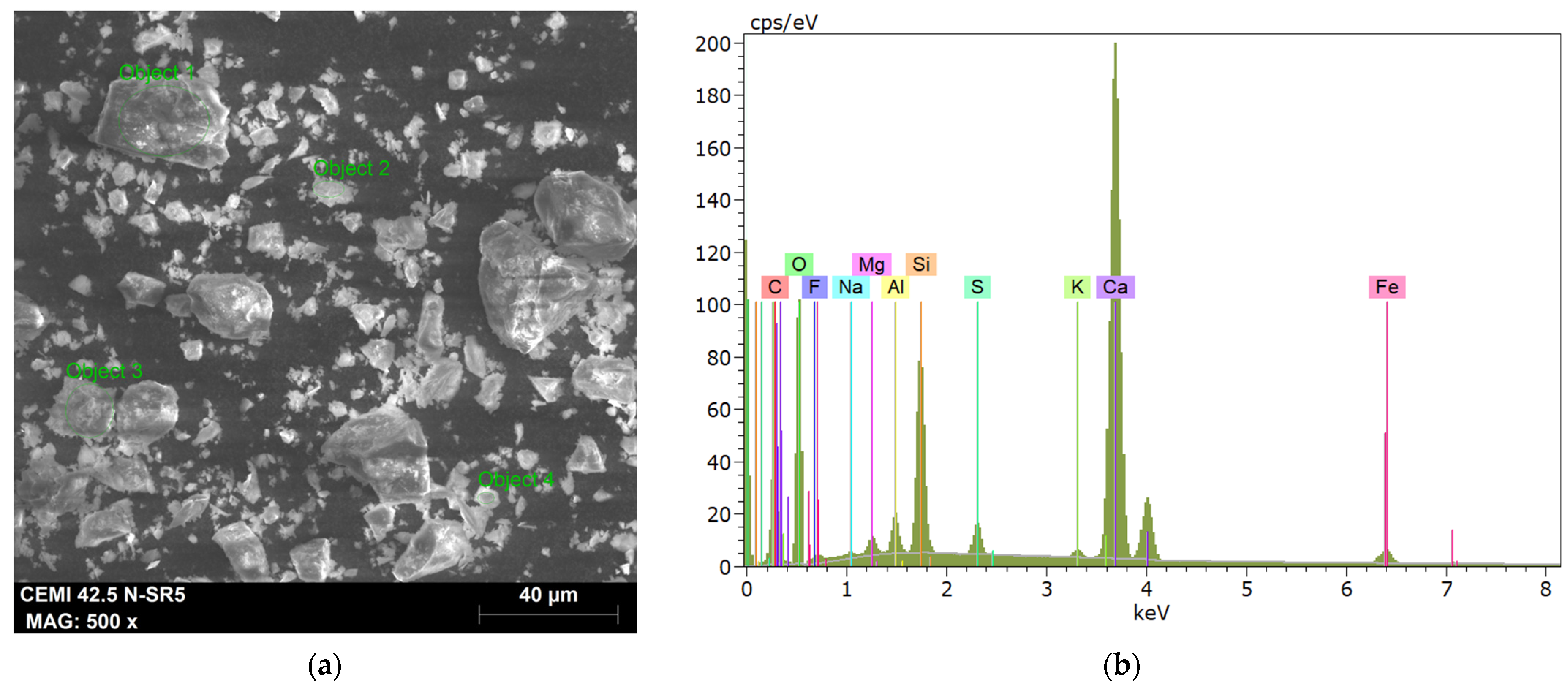
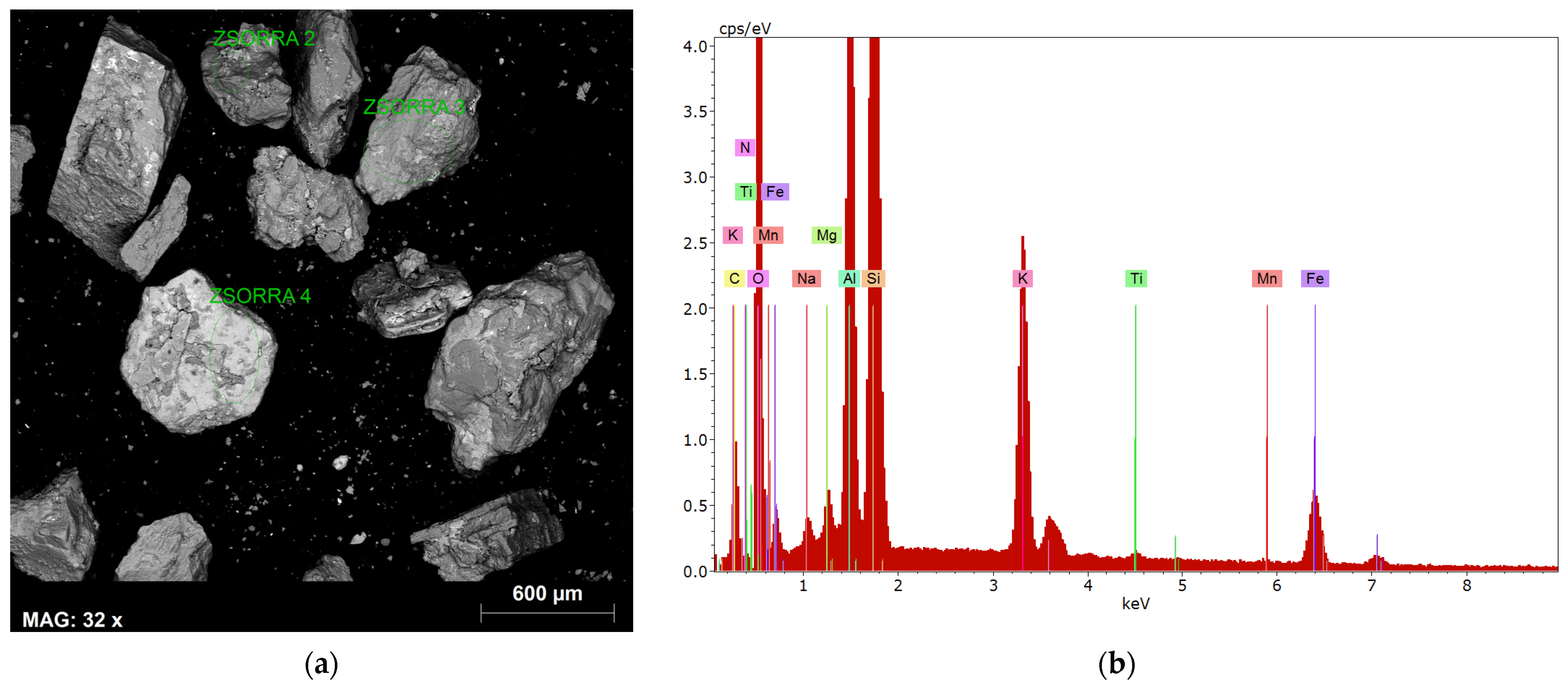

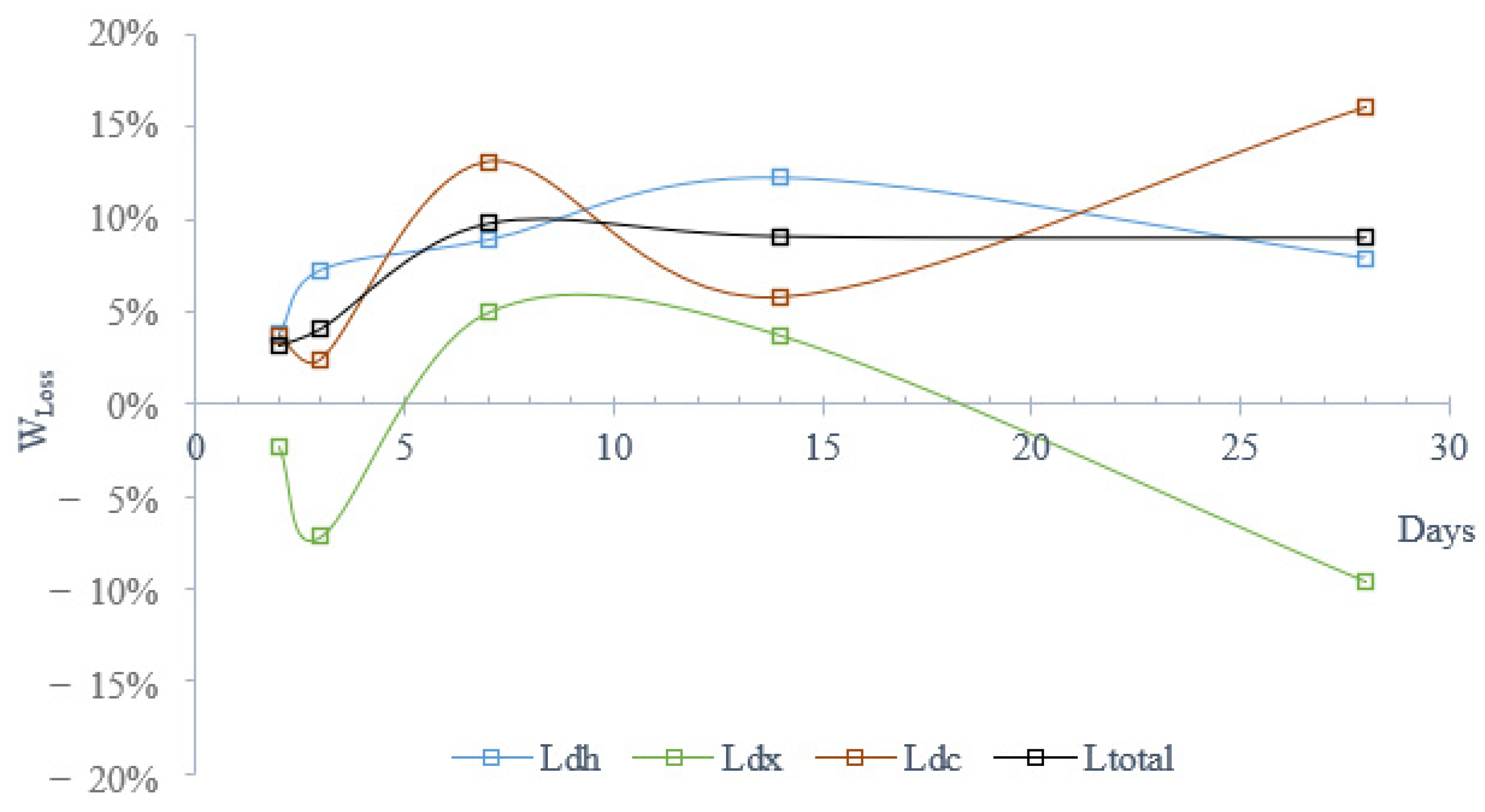


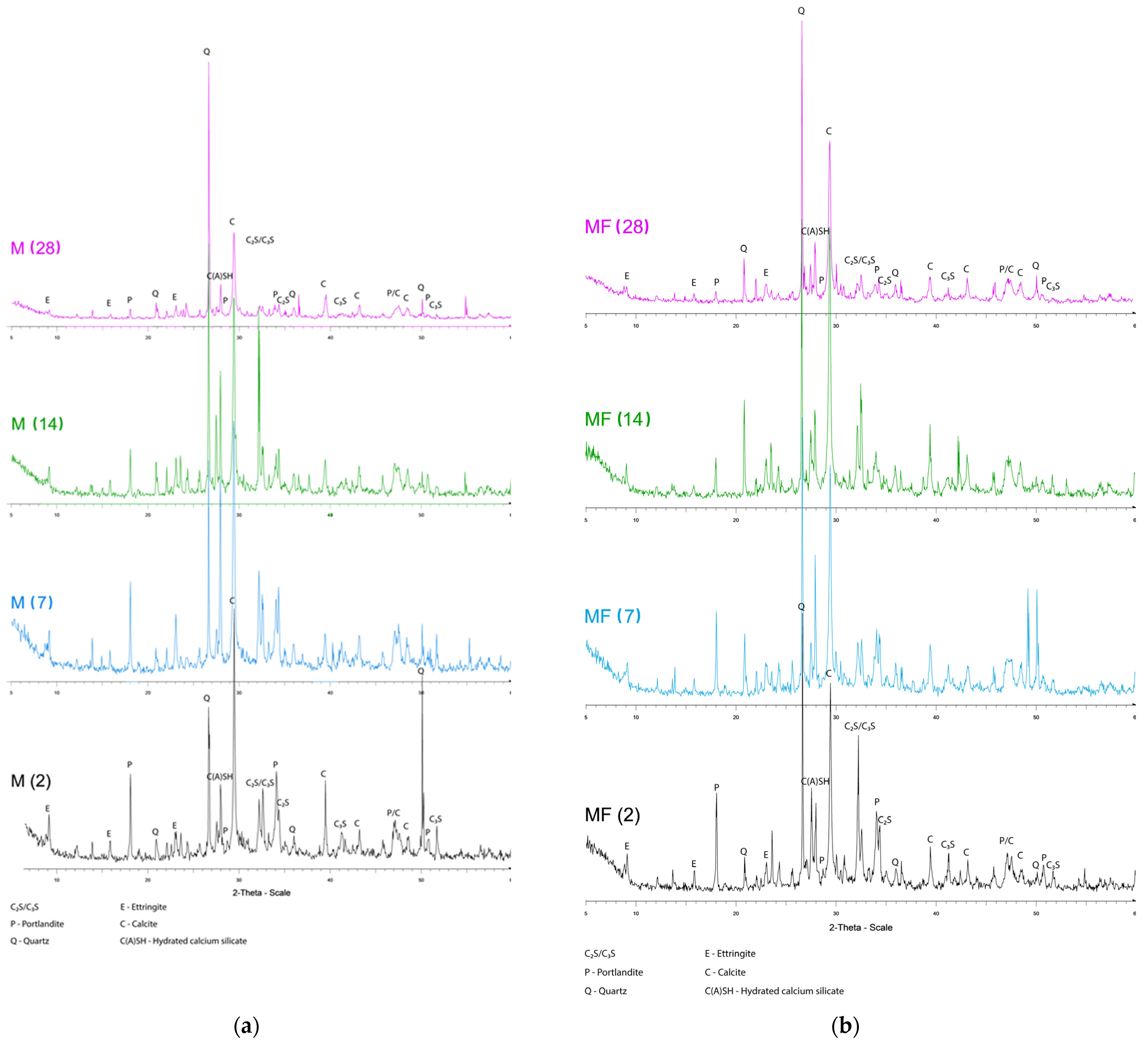

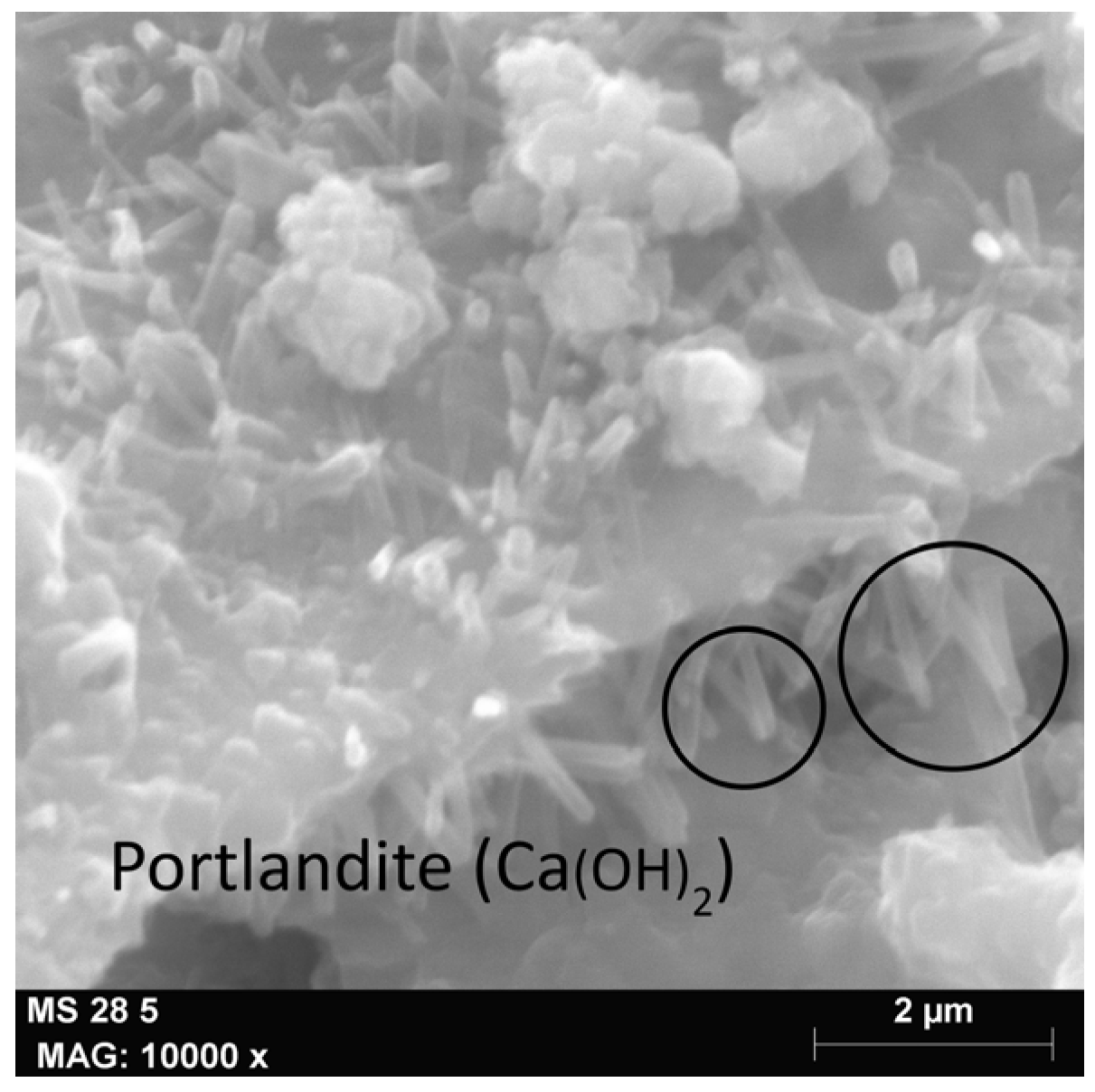

| Authors | Range Values | ||
|---|---|---|---|
| Ldh | Ldx | Ldc | |
| Bhatty [37] | 105–440 °C | 440–580 °C | 580–1000 °C |
| Pane et al. [39] | 140–440 °C | 440–520 °C | 520–1100 °C |
| Monteagudo et al. [34] | 105–430 °C | 430–530 °C | 530–1100 °C |
| Element | Average % | ||
|---|---|---|---|
| Cement | Sand | Fiber | |
| C | 4.00 | 15.34 | 65.99 |
| O | 48.34 | 47.74 | 32.34 |
| Mg | 0.66 | 1.73 | - |
| Al | 1.36 | 7.18 | - |
| Si | 5.47 | 13.75 | - |
| Ca | 35.38 | 0.26 | 1.20 |
| K | 0.83 | 3.75 | 0.47 |
| Na | 0.26 | 0.20 | - |
| S | 0.45 | - | - |
| Fl | 0.80 | - | - |
| Cl | - | 0.01 | 0.01 |
| Fe | 2.46 | 8.69 | - |
| Ti | - | 0.67 | - |
| Mn | - | 0.10 | - |
| Ni | - | 0.60 | - |
| Specimen | Curing Time (Days) | Weight Losses % | Chemically Bound Water | Hydration Degree | |||
|---|---|---|---|---|---|---|---|
| Ldh | Ldx | Ldc | Ltotal | (WB) % | |||
| M2 | 2 | 8.0287 | 1.6333 | 5.2408 | 14.9028 | 11.8107 | 49.21 |
| M3 | 3 | 8.3771 | 1.9306 | 5.0795 | 15.3872 | 12.3903 | 51.63 |
| M7 | 7 | 8.5237 | 1.9035 | 4.6927 | 15.1199 | 12.3512 | 51.46 |
| M14 | 14 | 8.4500 | 2.0200 | 5.4432 | 15.9132 | 12.7017 | 52.92 |
| M28 | 28 | 8.0277 | 2.1218 | 5.4292 | 15.5787 | 12.3755 | 51.56 |
| MF2 | 2 | 8.3505 | 1.5965 | 5.4428 | 15.3898 | 12.1785 | 50.74 |
| MF3 | 3 | 9.0348 | 1.8011 | 5.2054 | 16.0413 | 12.9701 | 54.04 |
| MF7 | 7 | 9.3561 | 2.0033 | 5.4003 | 16.7597 | 13.5735 | 56.56 |
| MF14 | 14 | 9.6306 | 2.0985 | 5.7764 | 17.5055 | 14.0974 | 58.74 |
| MF28 | 28 | 8.7187 | 1.9361 | 6.4663 | 17.1211 | 13.3060 | 55.44 |
Disclaimer/Publisher’s Note: The statements, opinions and data contained in all publications are solely those of the individual author(s) and contributor(s) and not of MDPI and/or the editor(s). MDPI and/or the editor(s) disclaim responsibility for any injury to people or property resulting from any ideas, methods, instructions or products referred to in the content. |
© 2023 by the authors. Licensee MDPI, Basel, Switzerland. This article is an open access article distributed under the terms and conditions of the Creative Commons Attribution (CC BY) license (https://creativecommons.org/licenses/by/4.0/).
Share and Cite
Llorens, J.; Julián, F.; Gifra, E.; Espinach, F.X.; Soler, J.; Chamorro, M.À. An Approach to Understanding the Hydration of Cement-Based Composites Reinforced with Untreated Natural Fibers. Sustainability 2023, 15, 9388. https://doi.org/10.3390/su15129388
Llorens J, Julián F, Gifra E, Espinach FX, Soler J, Chamorro MÀ. An Approach to Understanding the Hydration of Cement-Based Composites Reinforced with Untreated Natural Fibers. Sustainability. 2023; 15(12):9388. https://doi.org/10.3390/su15129388
Chicago/Turabian StyleLlorens, Joan, Fernando Julián, Ester Gifra, Francesc X. Espinach, Jordi Soler, and Miquel Àngel Chamorro. 2023. "An Approach to Understanding the Hydration of Cement-Based Composites Reinforced with Untreated Natural Fibers" Sustainability 15, no. 12: 9388. https://doi.org/10.3390/su15129388






